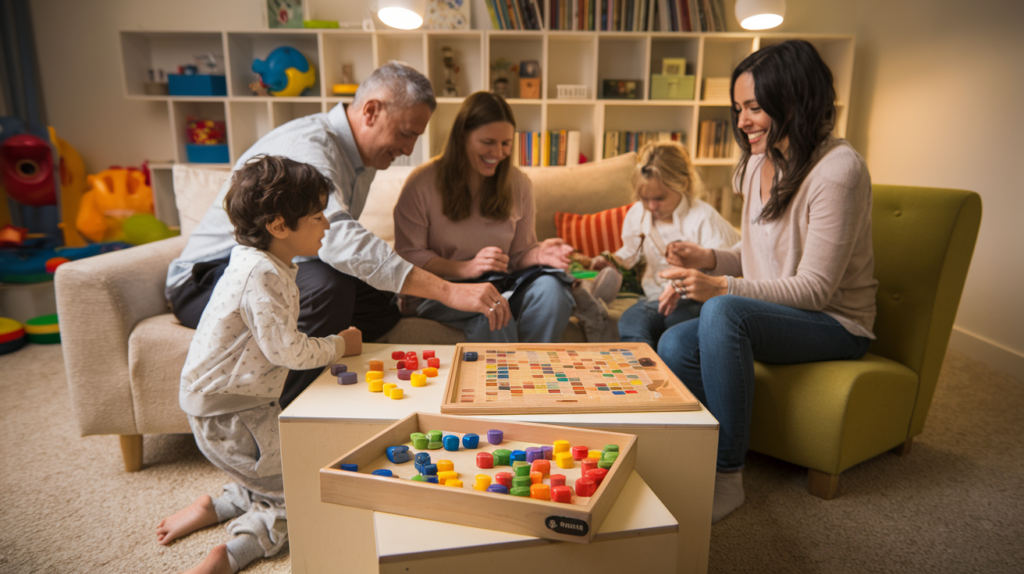
Receiving an autism diagnosis for your child brings a complex mix of emotions. Alongside the desire to provide the best possible support, it’s natural for parents and siblings to have worries or anxieties about how this will change family life. However, with love, understanding, and a few key strategies, your family can navigate this new chapter with resilience and unity. This guide offers 5 essential tips to strengthen family bonds throughout your autism journey.
1. Focus on Understanding and Acceptance
Understanding autism is the first step toward preserving family bonds after an autism diagnosis. The more you comprehend autism spectrum disorder (ASD), the better equipped you’ll be to support your child and navigate challenges.
Become an Autism Expert
- Reliable Resources: Utilize organizations like the Autism Society and Autism Speaks for accurate information.
- Child-Specific Insights: Focus on how autism manifests in your child, such as sensory sensitivities or social communication differences.
Embrace Neurodiversity
- Celebrate Uniqueness: Recognize and celebrate your child’s unique qualities while supporting areas that need improvement.
Educate Siblings
- Age-Appropriate Information: Share factual information with siblings to foster understanding and reduce confusion or resentment.
- Sibling Resources: Utilize books specifically about autism for siblings to aid in their comprehension.
Understanding autism builds a foundation for acceptance within your family, fostering an environment where your autistic child can thrive.
How to Increase My Understanding of Autism Spectrum Disorder?
- Seek Reliable Sources: Focus on reputable organizations like Autism Speaks, The National Autistic Society, and the Centers for Disease Control and Prevention (CDC).
- Learn About Sensory Differences: Understand how sensory sensitivities affect your child’s daily life.
- Explore Social Communication: Learn about challenges with nonverbal cues and typical conversations.
- Listen to Autistic Voices: Engage with books, blogs, and social media from autistic adults for firsthand perspectives.
- Continuous Learning: Attend workshops, conferences, and connect with other families to stay informed.
2. Communication is Key
Open communication is vital for maintaining strong family relationships, especially after an autism diagnosis. Prioritize creating a safe space for sharing feelings and supporting one another.
Meet Your Child Where They Are
- Adapt Communication: Learn your child’s communication style—verbal, nonverbal, picture cards, or devices—and adapt accordingly.
Encourage Sibling Voices
- Validate Feelings: Let siblings know it’s normal to have mixed emotions and explain their brother’s or sister’s differences compassionately.
Hold Family Meetings
- Regular Check-Ins: Schedule times to discuss wins, challenges, and support needs, adapting as your family’s needs change.
Practical Example: Scheduling “Sibling Time” If an autistic child has intensive therapy schedules, set aside at least 15 minutes of uninterrupted, one-on-one time for a neurotypical sibling to feel seen and heard, even if it’s just reading stories together.
How Do I Make Communication Between My Autistic Child and Their Siblings Easier?
Shared Activities: Engage in activities siblings can enjoy together, such as parallel play, sensory activities, or simple games with clear rules.
Practical Example: “Show and Tell” for Preverbal Kids Encourage autistic children who aren’t yet talking to communicate preferences during play by pointing or exchanging picture cards.
Modeling Empathy: Demonstrate how to talk about feelings related to autism, fostering understanding and compassion among siblings.
3. Prioritize Self-Care and Support Systems
Parenting any child requires incredible dedication, and supporting an autistic child can be especially demanding. Remember, you cannot give your best to your family if you are running on empty.
Avoid Burnout
- Self-Care: Prioritize sleep, healthy eating, and carve out time for activities you enjoy, even in small increments.
Support Groups
- Connect with Other Parents: Join in-person or online groups to share experiences and reduce feelings of isolation.
Respite Care
- Take Breaks: Explore respite options to care for your child while you recharge.
Ask for Help
- Leverage Your Community: Don’t hesitate to ask family, friends, or your wider community for assistance with meals, babysitting, or errands.
Practical Example: Self-Care Swap Partner with another autism parent for a “self-care trade” – taking turns watching each other’s children for an hour to allow for solo errands, a bath, or quiet time.
How Can I Support My Own Mental Well-Being as an Autism Parent?
- Validate Emotions: Acknowledge that it’s okay to feel a mix of grief, worry, pride, and determination.
- Seek Therapy: Consider individual therapy to process complex emotions, especially with a therapist specializing in supporting parents of children with special needs.
- Practice Self-Compassion: Be kind to yourself, focus on progress over perfection, and celebrate your resilience.
- Set Realistic Expectations: Accept that some days will be harder than others and prioritize basic needs.
- Mindfulness & Relaxation Techniques: Engage in deep breathing, guided meditation, or calming activities.
- Connect with Other Parents: Join support groups to share experiences and feel less alone.
- Respite is Not a Luxury: Explore respite care options to ensure you can continue caring for your child long-term.
4. Adjust Expectations and Celebrate Milestones
An autism diagnosis may require you to redefine what you consider “normal” for your family. Focusing on progress over external expectations helps you and your child thrive.
Celebrate All Victories
- Recognize Small Improvements: Celebrate milestones like learning a new word, trying a new food, or making a friend.
Focus on Strengths
- Highlight Unique Abilities: Emphasize your child’s strengths and interests to boost their confidence and self-esteem.
Flexibility is Key
- Embrace Detours: Be prepared to adapt to unexpected challenges, reducing stress and finding success in unpredictable circumstances.
Practical Example: Visual Progress Chart Create a visual chart with your autistic child to mark progress towards reducing certain meltdown triggers, using stickers or other motivating symbols.
Social Practice Example: Focus on Effort, Not Just Results Praise efforts such as listening to the coach and cooperating in team sports, even if your child doesn’t score a goal.
5. Make Time for Family Fun
Amidst therapies, doctor’s appointments, and skill-building, it’s essential to carve out space for pure family enjoyment. Shared positive experiences build strong bonds and create lasting memories.

Include Special Interests
- Incorporate Passions: Integrate your child’s interests, like dinosaurs or trains, into family outings and activities.
Sensory-Aware Outings
- Research Autism-Friendly Events: Look for sensory-friendly movie screenings, museum days, or community events tailored for autistic individuals.
Focus on Family Connection
- Quality Family Time: Engage in activities everyone enjoys, such as game nights, nature walks, or reading together.
Practical Example: Sensory-Friendly Game Night Choose board games that are less overstimulating and modify rules if necessary, focusing on having fun rather than rigid game completion.
Social Practice Example: Shared Storytelling Have each family member contribute a sentence to create a silly story together, fostering imagination and turn-taking in a low-pressure environment.
What Are Some Autism-Friendly Activities I Can Do as a Family?
Explore Sensory-Friendly Events:
- Sensory-Friendly Movies: Attend screenings with lowered volume, dimmed lighting, and relaxed rules.
- Museums and Zoos: Participate in special “sensory hours” with smaller crowds and adjusted environments.
- Autism Community Events: Join picnics, carnivals, or adapted sports events hosted by organizations like Autism Speaks.
Adapt Mainstream Activities for Success:
- Sporting Events: Attend shorter games or practice sessions with noise-canceling headphones and fidget toys.
- Restaurants: Choose off-peak times and quieter booths to reduce anxiety.
- Shopping Trips: Visit during less busy hours and break the trip into smaller errands with play-breaks in between.
Focus on At-Home Fun:
- Build a Sensory Fort: Create a cozy space with pillows, blankets, and calming textures.
- Backyard Camping: Enjoy outdoor adventures at home with activities like roasting marshmallows and storytelling.
- “Special Interest” Nights: Theme family evenings around your child’s favorite topics, such as dinosaurs or trains.
Remember: The most important thing is togetherness. Choose activities that prioritize connection and modify anything that feels too overwhelming for your autistic child. Success builds confidence for future adventures!
Conclusion
An autism diagnosis brings change, but it doesn’t have to weaken your family bonds. By focusing on understanding, communication, attending to everyone’s needs, celebrating your child’s uniqueness, and making time for connection, your family can grow stronger together. These challenges can lead to deeper empathy, resilience, and unwavering love for each other on your unique autism journey.


